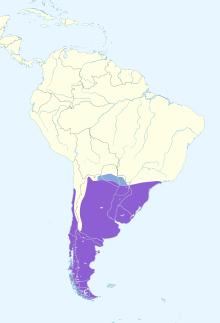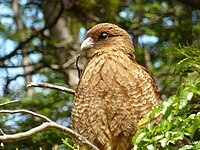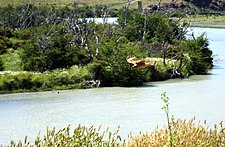Chimango caracara
| Chimango caracara | |
|---|---|

| |
| Nominate in Rio Grande do Sul, Brazil | |
| Scientific classification | |
| Domain: | Eukaryota |
| Kingdom: | Animalia |
| Phylum: | Chordata |
| Class: | Aves |
| Order: | Falconiformes |
| Family: | Falconidae |
| Genus: | Milvago |
| Species: | M. chimango
|
| Binomial name | |
| Milvago chimango (Vieillot, 1816)
| |

| |
| Synonyms | |
The chimango caracara also known as chimango or tiuque (Milvago chimango) is a species of bird of prey in the family Falconidae, the falcons and caracaras.[4] It is found in Argentina, Bolivia, Brazil, Chile, Paraguay, and Uruguay, as a vagrant on the Falkland Islands and has been introduced on Rapa Nui.[5]
Taxonomy and systematics
[edit]The taxonomy of the caracaras has not been settled. The American Ornithological Society and the International Ornithological Committee place the chimango and yellow-headed caracaras in genus Milvago.[6][4] BirdLife International's Handbook of the Birds of the World places the chimango caracara and four others in genus Phalcoboenus and the yellow-headed caracara alone in Milvago.[2] The Clements taxonomy places the chimango, yellow-headed, and four other caracaras in genus Daptrius.[7][3] The other systems place only the black caracara in Daptrius.[6][4][2]
The worldwide systems agree that the chimango caracara has two subspecies, the nominate M. c. chimango (Vieillot, 1816) and M. c. temucoensis (Sclater, 1918).[4][2][3] The population in Tierra del Fuego has sometimes been proposed as a third subspecies, M. c. fuegiensis.[8]
Description
[edit]The chimango caracara is 32 to 43 cm (13 to 17 in) long and weighs 170 to 260 g (6.0 to 9.2 oz). Its wingspan is 80 to 99 cm (31 to 39 in). The sexes' plumages are alike. Adults of the nominate subspecies are mostly brownish throughout. They have dark streaks on the side of the head and on their hindneck. Their undersides are mottled or barred with rufous-brown. Their uppertail coverts are white and their tail is mottled grayish and white with a wide black band near the end. Also, their iris is brown. Males have bare yellow skin around the eye and yellow legs and feet. Females have reddish-pink skin around the eye and bluish-gray legs and feet. Juvenile birds have a strong rufous tinge overall and bare parts colored like the adult females. Subspecies M. c. temucoensis is a darker smoky brown than the nominate, and their underparts are more heavily marked.[9][8]
Distribution and habitat
[edit]The nominate subspecies of the chimango caracara is found in northern and central Chile and from central Argentina east through Paraguay, southern Brazil, and Uruguay to the Atlantic Ocean. It is also a non-breeding visitor north into Bolivia. Subspecies M. c. temucoensis is found from southern Chile at about Concepción Province and southern Argentina at about the Chubut River south through Tierra del Fuego to Cape Horn. Individuals have roamed to the Falkland Islands. In addition, the species was introduced to Easter Island in the early 20th century.[8][5][10]
The chimango caracara inhabits a wide variety of open landscapes including grassy Andean foothills, heathland, shrub–steppe, and marshes. It also occurs in open woods, plantations, villages, suburban and urban areas, and coastal flats. In Argentina it is often found along roads and areas with a mix of pristine and disturbed plots.[8] One author says it is most common in the ranching and wheat belt of the Argentinian Pampas, around Chilean fishing villages, around extensive marshlands, and at "rubbish dumps anywhere".[9] It is the most common raptor in Argentinean Patagonia.[11] In elevation it is most common below 2,000 m (6,600 ft) but is regularly found up to 3,000 m (9,800 ft) and occasionally as high as 4,000 m (13,000 ft).[9]
Behavior
[edit]Movement
[edit]The chimango caracara is a year-round resident in most of its range. Populations in the far south are partially migratory, with individuals moving north mostly in the austral winter. Members of the northern populations move into Bolivia in the non-breeding season and also in small numbers as far north in Brazil as Minas Gerais and Goiás. There are a few records from the Falkland Islands.[9][8][5]
Feeding
[edit]The chimango caracara is omnivorous, "a small-scale predator and general scavenger".[9] Its live prey include insects and other invertebrates, lizards, amphibians, the eggs and young of other birds, and rodents. It scavenges small roadkill and also the carcasses of larger animals after other predators have left. It eats smaller amounts of vegetable matter like rotten apples, fungi, and what it can glean from horse and cattle dung. Furthermore, it typically forages on the wing, flying somewhat randomly up to 10 m (30 ft) above the ground and dropping onto prey or other food sources. It often follows farmers as they plow (assemblies of more than 100 birds have been observed), congregates at grass fires, and frequents fishing villages and shellfish processing plants for their waste. It pirates food from other raptors and large waterbirds.[9][8] Individuals have been observed catching live fish from the surface of water.[12]
Breeding
[edit]The chimango caracara's breeding season spans September to January, with eggs laid from mid-October to mid-November in much of its range. It usually nests in trees, building a stick platform up to about 30 m (100 ft) above the ground, but much lower in Patagonia and oriented to avoid prevailing winds. In areas with few trees, it will nest on the ground or tussocks in a marsh. Tree nests of adjoining pairs are usually fairly far apart. Ground nesting can be colonial, for example, an observation of more than 70 nests in a 1.5 ha (3.7 acres) site. The clutch size is usually two or three eggs but up to five is not uncommon. The incubation period is 26 to 32 days and fledging occurs 32 to 41 days after hatch. Both sexes build the nest, incubate the clutch, and provision the young.[9][8]
Cognitive behavior
[edit]The chimango caracara is an intelligent bird and has high problem-solving abilities compared to other birds. "The explorative tendency, low neophobia, and ability to innovate showed by M. chimango may be advantageous for this generalist and opportunistic raptor and might be some of the factors underlying its ecological success."[13]
Vocalization
[edit]The chimango caracara is usually most vocal during the breeding season "particularly if human or other intruders [are] near nest", but also calls during disputes over food. Its most common call is a "loud petulant squealing keeeeee-eh" that is usually made singly and often in flight. It also makes a "more chattering...keag-keah-keah..." or "ke-ew, ke-ew, ke-ew" and a "variety of squeals, growls, and hissing whistles."[9]
Status
[edit]The IUCN has assessed the chimango caracara as being of Least Concern. It has a very large range, and though its population size is not known it is believed to be increasing. No immediate threats have been identified.[1] "Currently thriving, perhaps benefitting in part from deforestation, and is the commonest raptor through much of Chile and Argentina."[8]
Gallery
[edit]-
Chimango caracara. In Tierra del Fuego
-
In Torres del Paine National Park, Chile
-
Probably southern subspecies M. c. temucoensis, Dichato near Concepcion, Chile
References
[edit]- ^ a b BirdLife International (2018). "Chimango Caracara Phalcoboenus chimango". IUCN Red List of Threatened Species. 2018: e.T22696264A132066597. doi:10.2305/IUCN.UK.2018-2.RLTS.T22696264A132066597.en. Retrieved 14 February 2023.
- ^ a b c d HBW and BirdLife International (2022) Handbook of the Birds of the World and BirdLife International digital checklist of the birds of the world. Version 7. Available at: http://datazone.birdlife.org/userfiles/file/Species/Taxonomy/HBW-BirdLife_Checklist_v7_Dec22.zip retrieved December 13, 2022
- ^ a b c Clements, J. F., T. S. Schulenberg, M. J. Iliff, T. A. Fredericks, J. A. Gerbracht, D. Lepage, S. M. Billerman, B. L. Sullivan, and C. L. Wood. 2022. The eBird/Clements checklist of birds of the world: v2022. Downloaded from https://www.birds.cornell.edu/clementschecklist/download/ retrieved November 10, 2022
- ^ a b c d Gill, F.; Donsker, D.; Rasmussen, P., eds. (January 2023). "Seriemas, falcons". IOC World Bird List. v 13.1. Retrieved February 11, 2023.
- ^ a b c Remsen, J. V., Jr., J. I. Areta, E. Bonaccorso, S. Claramunt, A. Jaramillo, D. F. Lane, J. F. Pacheco, M. B. Robbins, F. G. Stiles, and K. J. Zimmer. 30 January 2023. Species Lists of Birds for South American Countries and Territories. https://www.museum.lsu.edu/~Remsen/SACCCountryLists.htm retrieved January 30, 2023
- ^ a b Remsen, J. V., Jr., J. I. Areta, E. Bonaccorso, S. Claramunt, A. Jaramillo, D. F. Lane, J. F. Pacheco, M. B. Robbins, F. G. Stiles, and K. J. Zimmer. Version 30 January 2023. A classification of the bird species of South America. American Ornithological Society. https://www.museum.lsu.edu/~Remsen/SACCBaseline.htm retrieved January 30, 2023
- ^ Fuchs, Jérôme; Johnson, Jeff A.; Mindell, David P. (2012-03-05). "Molecular systematics of the caracaras and allies (Falconidae: Polyborinae) inferred from mitochondrial and nuclear sequence data". Ibis. 154 (3). Wiley: 520–532. doi:10.1111/j.1474-919x.2012.01222.x. ISSN 0019-1019.
- ^ a b c d e f g h Bierregaard, R. O., G. M. Kirwan, and P. F. D. Boesman (2022). Chimango Caracara (Daptrius chimango), version 1.1. In Birds of the World (N. D. Sly, Editor). Cornell Lab of Ornithology, Ithaca, NY, USA. https://doi.org/10.2173/bow.chicar1.01.1 retrieved February 14, 2023
- ^ a b c d e f g h Ferguson-Lees, James; Christie, David A. (2001). Raptors of the World. New York: Houghton Mifflin. pp. 808–810. ISBN 0-618-12762-3.
- ^ Marín, M.; Cáceres, P. (2010). "Sobre las aves de Isla de Pascua". Boletín del Museo Nacional de Historia Natural (Chile). 59: 75–95. doi:10.54830/bmnhn.v59.2010.188.
- ^ Donázar, José A; Ceballos, Olga; Travaini, Alejandro; Hiraldo, Fernando (1993). "Roadside raptor surveys in the Argentinean Patagonia". Journal of Raptor Research. 27 (2): 106–110.
- ^ Sazima, Ivan; Olmos, Fabio (September 2009). "The Chimango Caracara (Milvago chimango), an additional fisher among Caracarini falcons". Biota Neotropica. 9 (3): 403–405. doi:10.1590/S1676-06032009000300036.
- ^ Biondi, Laura Marina; Bó, María Susana; Vassallo, Aldo Iván (1 September 2010). "Inter-individual and age differences in exploration, neophobia and problem-solving ability in a Neotropical raptor (Milvago chimango)". Animal Cognition. 13 (5): 701–710. doi:10.1007/s10071-010-0319-8. PMID 20300791. S2CID 23755597.
External links
[edit]Further reading
[edit]- Meiburg, Jonathan (2021). A Most Remarkable Creature. New York: Alfred A. Knopf. ISBN 9781101875704.





